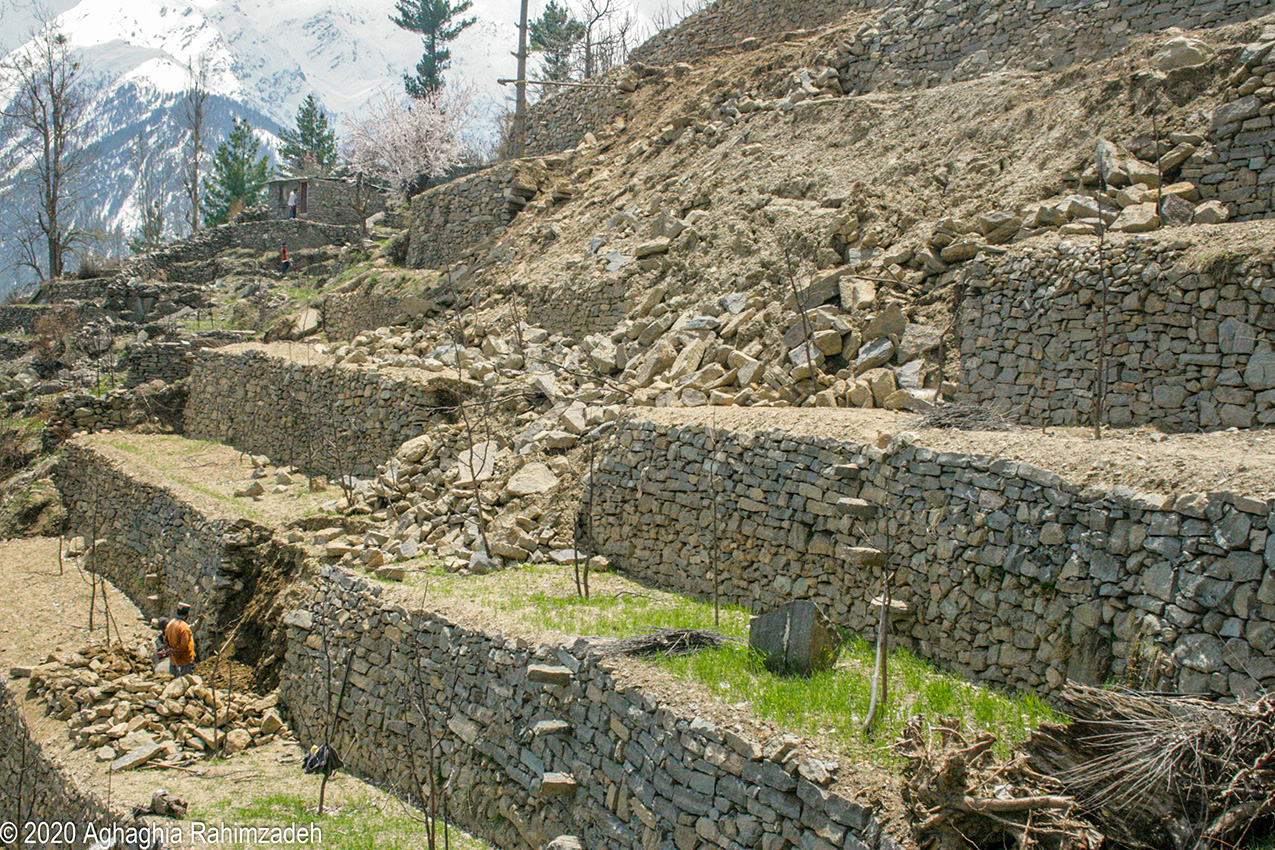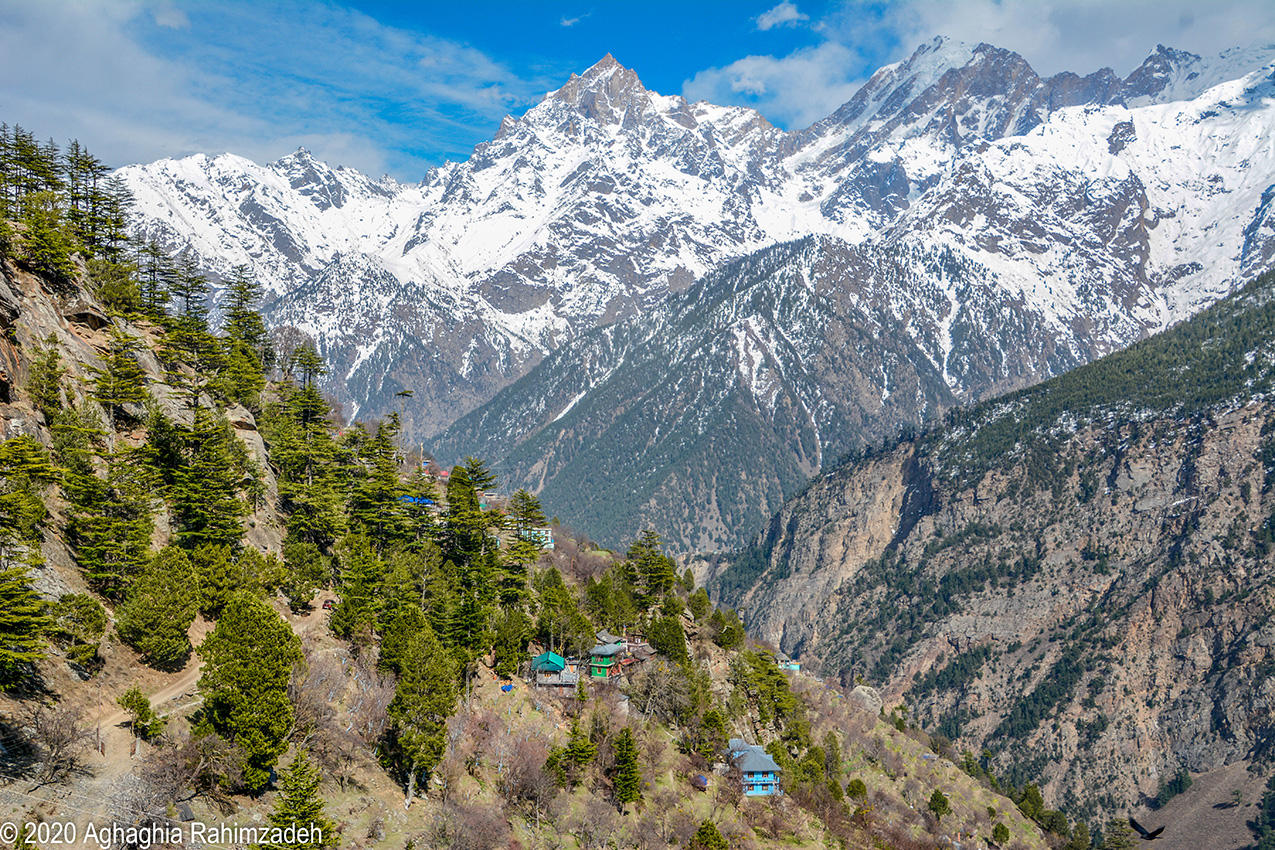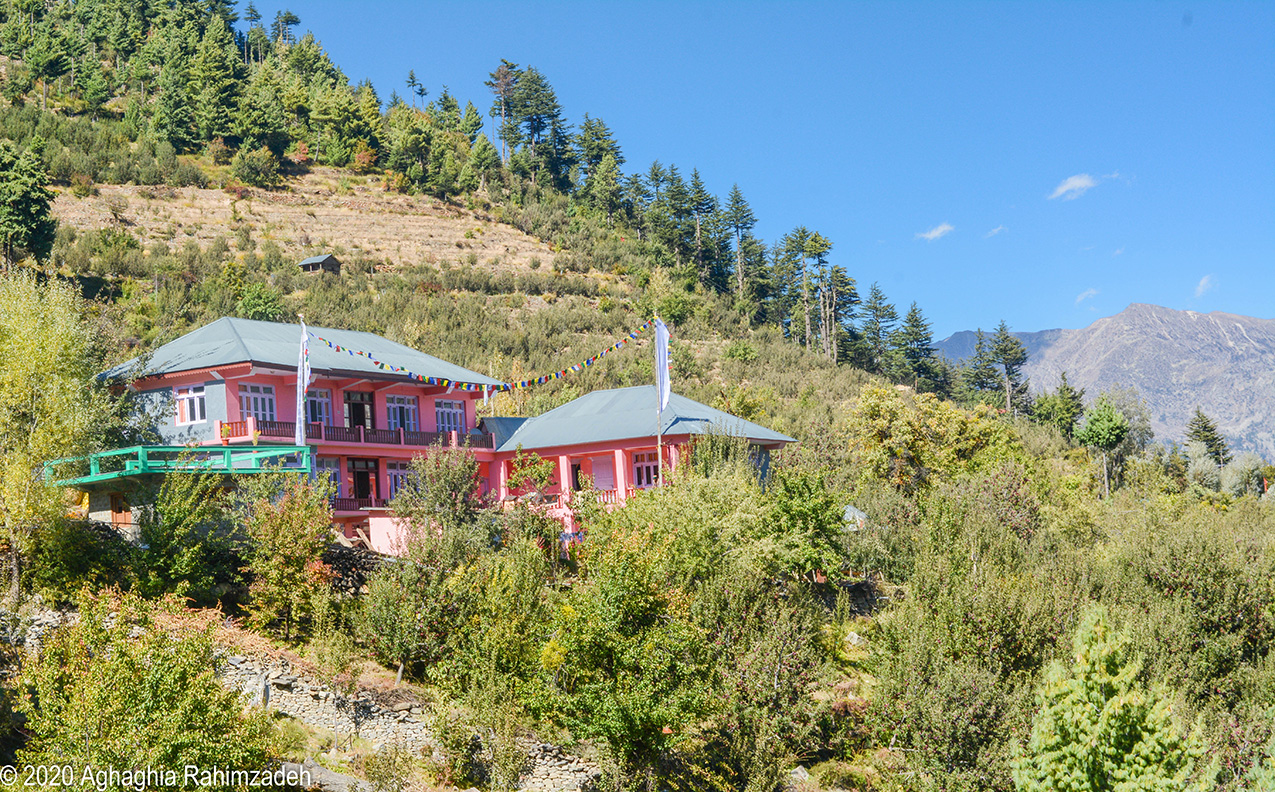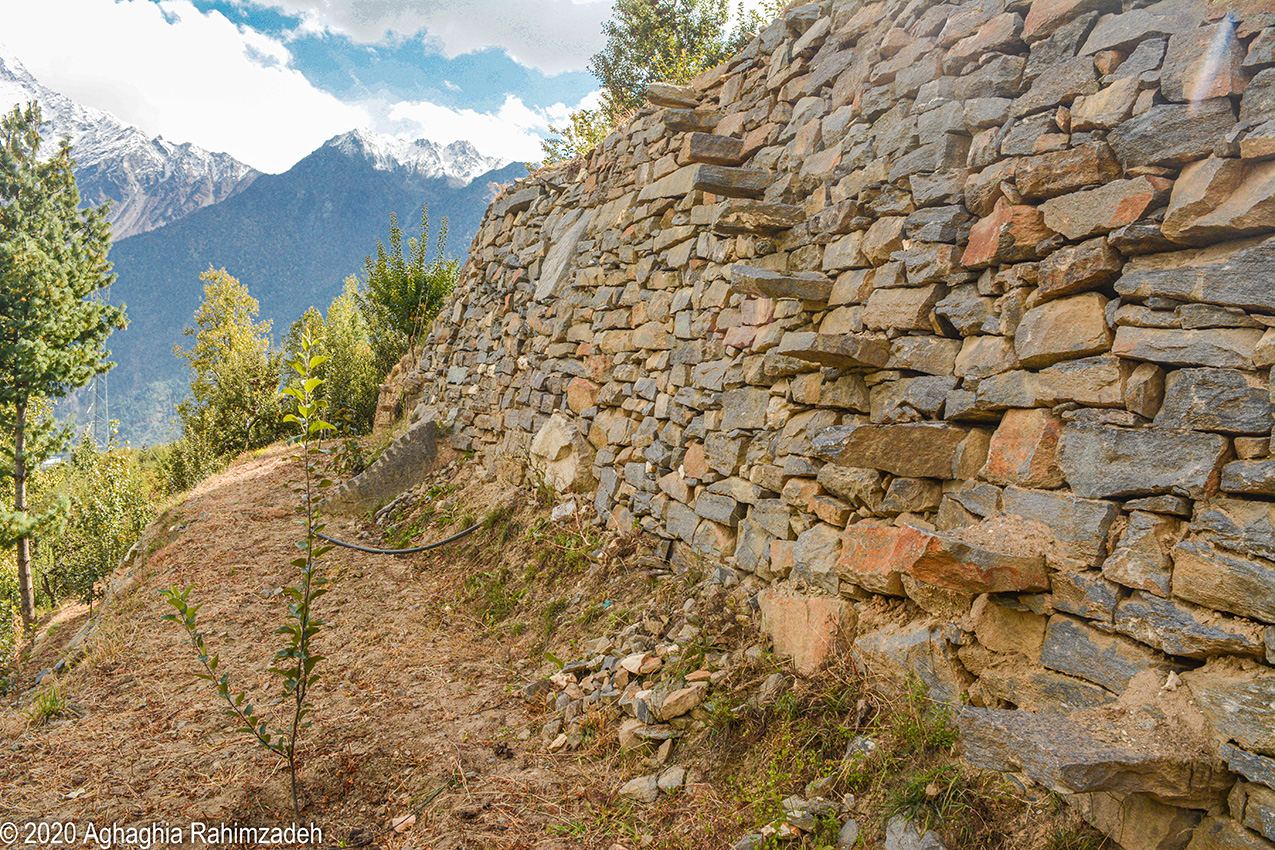Living in the village of Kalpa, I was studying the impacts of climate change. I was shocked when the tiny apple saplings and meticulous terraces, newly built by Nepali workers, were destroyed by a landslide. Yet as unusually severe as that winter of 2013 had been in the Western Himalaya, I came to see that the ruined orchard held the story of a changing climate, uncertain and unpredictable. I could see from my room the massive developing orchard, one spanning the steep hillside. The orchard belonged to Mr. Suraj Lal who lived in a large pink house nearby. The respected elder, like others in Kinnaur, had prospered from the region’s apple economy.
His orchard had been built by the hard-working Nepali laborers who toiled for months, hauling and hoisting one stone at a time, developing the terraces on this precipitous Himalayan slope. The Nepalis are well-known for their expert skill in stonework and terrace development, all fashioned with their bare hands. Creating terraces on these steep slopes is quite an endeavor. The plots are generally small because cultivable land is scarce in this rocky mountainous region. Since Mr. Suraj Lal’s orchard was on a steep slope, it required building narrow and vertically tall terraces. Every terrace is stabilized with retaining walls of large stones that are laboriously chipped into small pieces, then skillfully fitted to create a sturdy wall. Large flat slabs of stones jutting out from the terrace walls, among the largest I had seen, made a diagonal staircase connecting each level.
It was now spring and the area was still under a heavy cloak of snow, submerged in the tranquil silence of winter. The region of Kinnaur had experienced an extremely severe winter. Kalpa Village had received eleven feet of snow and landslides destroyed homes, orchards, and roads throughout the district. Although the overall snowfall in Kinnaur has diminished in recent years, contributing to water shortages, community elders recounted never experiencing such a heavy snow. Here, as everywhere, unpredictable weather patterns are becoming more common. A rise in climate variability is leading to severe disasters like the one Kinnauris experienced that winter.
Mr. Suraj Lal’s newly-built orchard was among those buried by the massive landslide. That spring, however, the Nepali laborers, once again, restored the terraces, planting them with new apple trees. Rebuilding and replanting the orchard in the face of rapid changes represents the resiliency of this mountain community.

Six years later, as I again walked through the orchards of Kinnaur with my friend and research assistant, Tania, our hearts pounded and our breathing slowed at this elevation of 10,000 feet. The oldest apple trees in Mr. Suraj Lal’s orchard were nearing fruit-bearing age. The terraces had also been planted with younger, three-to-four-year-old apple trees. Living in such an environmentally precarious area, the Kinnauris have learned to construct a terrain that is both habitable and profitable. The prosperity of the region’s apple economy of the last several decades has propelled people to maximize their orchards by planting new trees between older ones on every piece of available land. Prior to the introduction of apples as a cash crop in the 1950s, Kinnauris did not have a cash-based economy and people lived off their small plots of land and their animal herds. Now they rely on outside markets for their subsistence as apple cultivation has become the mainstay of their economy.
The relationship between Kinnauris and their environment is continuously evolving. People shape the environment through their constant use of resources, as well as their management practices and policies. Simultaneously, the environment is continually shaping human identity, culture, and livelihood practices. In the 1950s, the newly Independent Indian government sought to bring “backward” tribal people of Kinnaur—in other words, subsistence farmers and pastoralists who raised their own food—out of poverty . Seven decades later, this effort has resulted in the region’s heavy dependence on monoculture apple orchards, which have largely replaced traditional crops. But as the climate warms, more and more areas are opening up to orchards that are steadily encroaching on native forests and pasturelands at higher elevations. The limits of this process are unclear, but they are certain to be tested. This point was made all the more clear as I walked through the orchards of Kinnaur that spring day.
The weather had changed and warmed in the last couple of days, encouraging the emergence of spring. Ascending higher up the orchard, each terrace opened up a view into a different part of the surrounding area. The prodigious Kinner Kailash Mountain Range, with a cloak of snow and its tallest peak Jorkanden at 21,237 feet, loomed over the region. Layers of snow-covered mountain upon mountain extended into the distance as far as the eye could see. Forests of deodar cedar and pines inhabited the landscape. Small villages dotted the terrain, and apple orchards spread from the valley floor up the slopes toward the sky.

As we stood at the top of the orchard, we noticed Mr. Suraj Lal in the courtyard of the pink house in the distance. We waved, worried about having trespassed, but to our delight he waved back. Encouraged by his friendliness, we decided to visit the house.

As we entered, Mr. Suraj Lal, a short and stocky man in his 60s with a gentle and kind face, was sitting on a chair in the courtyard, enjoying the warm sun and the spectacular view of the august mountain in front of him.
After greetings and pleasantries, he brought two extra chairs. He then ran off returning with tea and a plate of biscuits, walnuts, and locally-harvested chilgoza pine nuts. As we talked, our host proved amiable, genuine, and well-informed. His shredded sleeves and calloused hands showed signs of his six decades of hard work. He had been a technician at the hospital in Rekong Peo, the district headquarters. Recently retired, he was now living permanently in this house. His humility glossed over his wealth, which he had attained from his employment, the prosperous apple economy, and probably acquired ancestral land. He laughed frequently and had a deeply peaceful demeanor. Sitting in his courtyard under the shadow of the mighty mountain had placed him in a deep state of presence and calm.
My assistant, Tania, with her friendly and convivial nature, explained to him my climate change research in Kinnaur. Her warmth eased my nerves and always comforted people. She recounted my years-long admiration for his orchard, especially the massive stone staircases imbedded into the terraces. Laughing and proud, he agreed and was impressed with outsiders’ knowledge of local details. I added in Hindi, “I remember the landslide that destroyed part of your orchard in the winter of 2013.”

Surprised, he paused, as if again feeling the pain of that event. “We’d just built the terraces, but that winter was so severe the foundation just wasn’t strong enough to hold the weight of all that snow.” He stared at his orchard in the distance, nodding.
“This year we’ve had a lot of snow again,” he explained, the conversation turning to the changing climate. “But before this winter, for two or three years, there was very little snow. Global warming is causing a lot of changes here in Kinnaur; changes I am observing myself.”
His Buddha-like peaceful presence captivated both me and Tania. Colorful prayer flags danced in the wind, spreading their prayers all around, while the baa-baa of a small herd of sheep and goats could be heard in the distance. He took a sip of tea and encouraged us to do the same.
“Before, we had snow in December. But now, we don’t get snow until January, February, and sometime, like this year, not until March and April. This late snowfall melts quickly. Look here.” He pointed to the courtyard where we were sitting. “There was so much snow here, but it has all melted in the heat of the last two-to-three days.”
This new weather pattern is being observed elsewhere across the Himalaya. According to Surjeet Singh Randhawa, a senior scientific officer at the Himachal Pradesh State Centre on Climate Change in Shimla, snow should stay at the source from December to February. But this later snow, high in water content, does not stay at the source, nor on the ground long-term. As it melts, it flows downward, causing soil erosion along the way, and sometimes its velocity destroys orchards, homes, and roads.
When the snow stays at its source from December to February, it melts gradually, slowly feeding irrigation channels and springs. Because the soil has a high sand and gravel content, and green cover is inadequate, the area is vulnerable to erosion and landslides. Due to the overall scarcity of land resources, people have no choice but to cultivate vulnerable areas, which are more prone to erosion. Additionally, the many newly-constructed roads on steep slopes exacerbate erosion and landslides.
Mr. Suraj Lal pushed the plate of walnuts and chilgoza pine nuts toward us and insisted we take more. Despite the gravity of his observations, he had a permanent smile on his glowing face. “If it doesn’t snow, then we will have a lot of water problems and our natural springs won’t get revived.” He stared thoughtfully at the glistening peaks in the distance.
The previous recent years had been challenging for many in Kinnaur. Some villages, like the village of Pooh in Upper Kinnaur, had to resort to trucking water several thousand feet up to their orchards from the Sutlej River, a costly effort not available to everyone.
“The future will be very difficult for the coming generations. Look at the mountains.” He pointed to several peaks on the Kinner Kailash straight ahead. “All those peaks had permanent snow on them. When I was growing up, you couldn’t see any bare rock. Where is the snow now?” He looked at us in distress. “Where will the water for the Sutlej River come from in the near future? All the hydropower projects will have to close. These dams are destroying our dwindling water source. In the past when there was no snow, we accessed our springs. But now the springs have dried up too, and the hydro projects take the remaining water.”
There was a sadness in his voice. Over the last few decades, his generations-old traditional way of life was rapidly changing. He, all too clearly, understood the implications of climate change for his community.
This concern about water is compounded by local development projects. Since the 1990s, the Sutlej Basin, which drains the Kinnaur Valley, has been inundated with a large number of hydroelectric dams. To meet its energy requirements, India has targeted its Himalayan rivers and small streams as a source of hydropower. Currently, there are a number of dams of various capacity on the Sutlej River and minor hydro projects on the small streams that provide a source of water to villages along their way. Many more dams are proposed for construction.
But with dams come problems, problems that are not shared by all. When building a dam, water is generally diverted from its source through tunnels that are blasted with dynamite on these fragile mountain slopes and channeled into reservoirs. Kinnauris complain about the destructive social and environmental impacts of these projects including landslides, flash floods, deforestation, waste and debris, desiccation of springs, water-borne and respiratory illnesses, and overall changes to river morphology. Yet these concerns are overshadowed by the government’s views on dams as symbols of progress, bringing electricity to certain parts of the country, while displacing or disrupting other, usually more rural, areas like Kinnaur. As these dammed waterways divert water away from village use, another process threatens them as climate change warms the region, limits rainfall and snowfall, and dries the riverbeds.
“In the near future, the next 40 to 50 years, even more of the snow on the mountain will disappear,” Mr. Suraj Lal lamented, pointing to the mountain again. “I am 60 years old and I have seen drastic changes in the amount of snow here in Kinnaur. With global warming, we have very little time left. I’m convinced that soon there will be no snow at all.”
In just the span of a few decades, Kinnauris are personally witnessing and living these changes. For one, orchard irrigation schedules are shifting. Kalpa irrigation water is brought down in kuhls (channels) from local glaciers. Each household has been receiving water for its orchards twice per month, but for some villages that is changing to once every three weeks. That limited amount is simply insufficient for growing a healthy orchard.
The unseasonable late snowfall in the springtime after blossoms have formed, or early snowfall in autumn before the harvest, can damage fruit and diminish the harvest. Also, although most Kinnauris speak of their aversion to spraying their orchards with chemicals, they feel compelled to do so in order to keep the proliferating pests and diseases at bay. More spray incurs more expenses for the orchard. Mr. Suraj Lal experienced these changes not just across the decades, but also daily.

As the apple zone migrates to higher areas, a network of newly-constructed roads to reach these new orchards accompanies this shift. Irrigated apple orchards are replacing the surrounding pine and cedar forests in a perverse ongoing relationship between giving new life and creating the right factors for more destruction.
In Kinnaur, climate change can be expected to result in a host of experiences including droughts, landslides, cloudbursts, and floods. Rapidly receding glaciers that are increasingly visible can have devastating effects. Glacial retreat can destabilize mountain slopes, leading to calamitous landslides that can potentially create lakes on river and stream beds, generating catastrophic floods.
In addition to affecting people in high elevation areas, shrinking glaciers profoundly influence the downstream water resources for millions of people in the lowlands who are highly dependent on mountain water for domestic, agricultural, and industrial use. The Hindu Kush Himalaya is the source of several important rivers including the Ganga (Ganges), the Indus, and the Brahmaputra that flow from Trans-Himalayan glaciers. These rivers provide water to 1.5 billion people and hence the area is referred to as the “water tower for Asia.”
“The future will be very difficult here in Kinnaur,” Mr. Suraj Lal repeated. “Everything needs water. Without water, there is nothing. If there is no snow, then there is no future.”
I tried a few times to question what could be done locally in the village of Kalpa to protect his orchards and prepare for future drought or flooding. Like many Kinnauris, Mr. Suraj Lal too placed the onus of responsibility on the government and repeatedly emphasized the government’s obligation to improve things.
“Global warming is a global issue and so many countries are involved,” Mr. Suraj Lal continued. “America, China, and Russia are some of the biggest polluters in the world. We do what we can here. But what can a handful of panchayats (local village councils) with a small footprint and small consumption pattern do?”
He was right. It is a global problem. The per capita fossil fuel CO2 emissions from countries of the Hindu Kush Himalaya is one-sixth of the global average. But the mountain regions experience the impact of climate change more acutely.
Like Kinnaur, other regions in the Himalaya are faced with threats of weather unpredictability related to anthropogenic climatic changes and societal pressures on the ecosystem. Rapidly changing local circumstances such as population growth, changing value systems and consumption patterns, pollution, unplanned and unregulated tourism, and what I term dilapidated development—or unplanned and unsustainable development—all undermine the integrity of the social and ecological systems of the region. Compounding these issues is an utter absence of any plans to safeguard themselves in light of hazards and crises. Solutions for mitigating the impacts of climate change will require both the local communities and national governments to be involved and take action, mitigate when possible, and, ultimately, adapt to the coming changes.
Working with the local communities to help design government policies and plans could be more effective in making these changes sustainable, and a significant step forward in developing resiliency of their local systems. In the case of Kinnaur, sustainable watershed management, in particular, is an important issue to undertake. Additionally, sustainable development as the key focus of any development interventions could help with mitigation and adaptation. Tourism in the region could be better regulated because it brings additional pressures on the ecosystem. Limiting the altitude where hotels are allowed to build would prevent further destruction to forests and hence prevent landslides.
Just as the unwelcome dam projects have demonstrated, a large divide exists between the government and local communities. Incorporating government policies, local people’s knowledge of their experiences, and scientific evidence on climate change may result in better solutions for mitigation and adaptation. Kinnauris can monitor the health of snowfields, glaciers, mountain springs, and permafrost, while enhancing their knowledge of their changing local ecosystem.
The sun was slowly leaving the courtyard and a mild breeze had picked up. There were now some clouds in the sky, as was the pattern in the afternoons. Mr. Suraj Lal apologized for needing to leave to feed the cows. He insisted we take the rest of the chilgoza pine nuts and walnuts. He also brought us some shriveled apples from the previous harvest, a kind gesture common in these parts. Saying our goodbyes and thanking him for his time, kindness and knowledge, we put on our down jackets and scarves, preparing for the cold of the late afternoon and evening.
“Please come back and visit again,” he said, his eyes filled with warmth. We assured him we would, then departed, walking on the path heading down toward the village. It was a beautiful late afternoon and the sweet aroma of wild apricot blossoms filled the air.
We walked back in silence for some time, contemplating our encounter. Tania and I had both been touched by this insightful and gentle man. The possible impending misfortunes awaiting this small Himalayan outpost were sobering. Mr. Suraj Lal’s orchard represents a microcosm of these issues in Kinnaur. The apple economy is precarious and uncertain. It may prove to be unsustainable. Roads, orchards, hotels, and larger homes are constructed without long-term forethought. Although Kinnaur has experienced climate disruptions in recent years, these events have not yet caused large-scale debilitating harm. Kinnauris still have a chance to adapt to these changes, to safeguard themselves and become more resilient to an unpredictable future.
On my many visits to Kinnaur since that winter of 2013, I have been perplexed at what initially appears to be the shortsightedness of the Kinnauris related to their future. I have expressed my concerns when engaging people in discussions and asking about what necessary measures they will take to safeguard against a changing climate. Can’t they see their dependence on a single cash crop is unsustainable? What about their children and their grandchildren? How will they sustain themselves when their apple orchards no longer produce? How will they protect themselves against severe water shortages? What happens if pests or disease strike the crops even more than they do now? Are they adapting to new crops that may withstand a warmer future? Unsurprisingly, the answers come down to some people are, but many are not.
But then I look at my own life in northern California and observe many similarities. I now live with the threat of wildfires, its severity worsening year after year. If an outsider were to observe my lifestyle, what might they make of how I—and others like me—prepare for the future amidst this threat? As I clear dry brush out of my garden and around my house to defend against the looming danger of wildfires, might they conclude that I’m not doing enough?
We, too, are faced with water issues. California is now officially in a megadrought with severe emergency water conservation measures in place. Our beautiful little nearby lake, home to many plant and animal species, is now bone-dry because its water has been pumped out to prepare for our impending water shortages during the hot summer season. Several of my friends are moving away from California, as are some Kinnauris moving to larger urban areas. But is there any place on the planet where we can be free from the perils of climate change? How sustainable are our own lifestyles in the developed countries that are the major contributors to climate change?


Climate change and unsustainable practices are not issues relevant only to Kinnaur. Around the world we live in short-term unsustainable relationships with the earth. Indeed, all of human history is characterized by such relationships. Many of us wait until one minute before midnight to take action. Consider our unsustainable industrial agriculture with adverse socio-economic and environmental repercussions. Unsustainable large-scale farming rapidly contributes to land degradation, destroying ecosystems and risking our food security, which can lead to poverty. We use dangerous chemicals that harm human health, induce desertification, and pollute the water and land, because they provide short-term benefits. Just as Mr. Suraj Lal’s orchard represents a microcosm of the broader issues in the Himalaya, Kinnaur itself embodies the problems we face globally. Until we turn the lens on our own practices and perspectives related to resource use and a changing climate, the apple orchards of Kinnaur may be unsustainable. But those who plant the trees do not deserve our judgment. They do deserve our reflection and some self-scrutiny. For the Kinnaris, elevation positions them as the first to feel the impacts of a warming climate. Like canaries in a coal mine, as they perish, so shall we. Because of the Himalayan Range’s continuous growth, it is seismically and tectonically an active system. The region, being the most unstable and fragile mountain zone in the world, contributes to relentless landslides and floods. The people in these magnificent mountains have learned to adapt. They may model for the rest of the world how to change with the changing climate.


